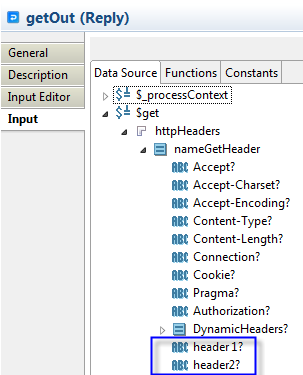Working with Header Parameters
Header parameters are used for user-defined custom HTTP headers for a request, for example, the APIKey could be a HTTP Header parameter. Unlike query and path parameters, header parameters do not appear in the URL of the request, but if they exist in your API specification, they get passed into the request but are not visible to the user.
If you created your REST API from an imported Swagger file , the parameters will not be editable in TIBCO Business Studio for BusinessWorks. You cannot modify existing parameters or create new ones. You can only view the parameters. Any custom header parameters you create, will be visible in the Data Source tab of the TIBCO Business Studio for BusinessWorks as follows:
You can view or add header parameters in the TIBCO Business Studio for BusinessWorks if the Swagger file for your project was auto-generated in the TIBCO Business Studio for BusinessWorks by implementing a REST service from XSD.
To add a custom header parameter, follow these steps:- Click Components under the Module Descriptors to open the Component Configurations page.
- Double-click the process name (with the green chevron next to it) to open its properties in the Properties view.
- Click the Bindings tab.
- Click an operation name in the Operations section.
- Click the Request tab in the Operation Details section.
- Click the red icon (
 ) to add a header parameter. To edit the parameter name click on the newly created parameter's default name and type in a new name. Be aware that these buttons will be disabled if you are viewing operations for an API that was created outside the
TIBCO Business Studio for BusinessWorks and imported into the
TIBCO Business Studio for BusinessWorks.
) to add a header parameter. To edit the parameter name click on the newly created parameter's default name and type in a new name. Be aware that these buttons will be disabled if you are viewing operations for an API that was created outside the
TIBCO Business Studio for BusinessWorks and imported into the
TIBCO Business Studio for BusinessWorks.
- You can also edit an existing header parameter to make it required or optional by clicking in the cell that corresponds to the parameter in the Required column. The value toggles from Yes to No or vice versa.
- Use the Response tab to add a header parameter to the operation response.

